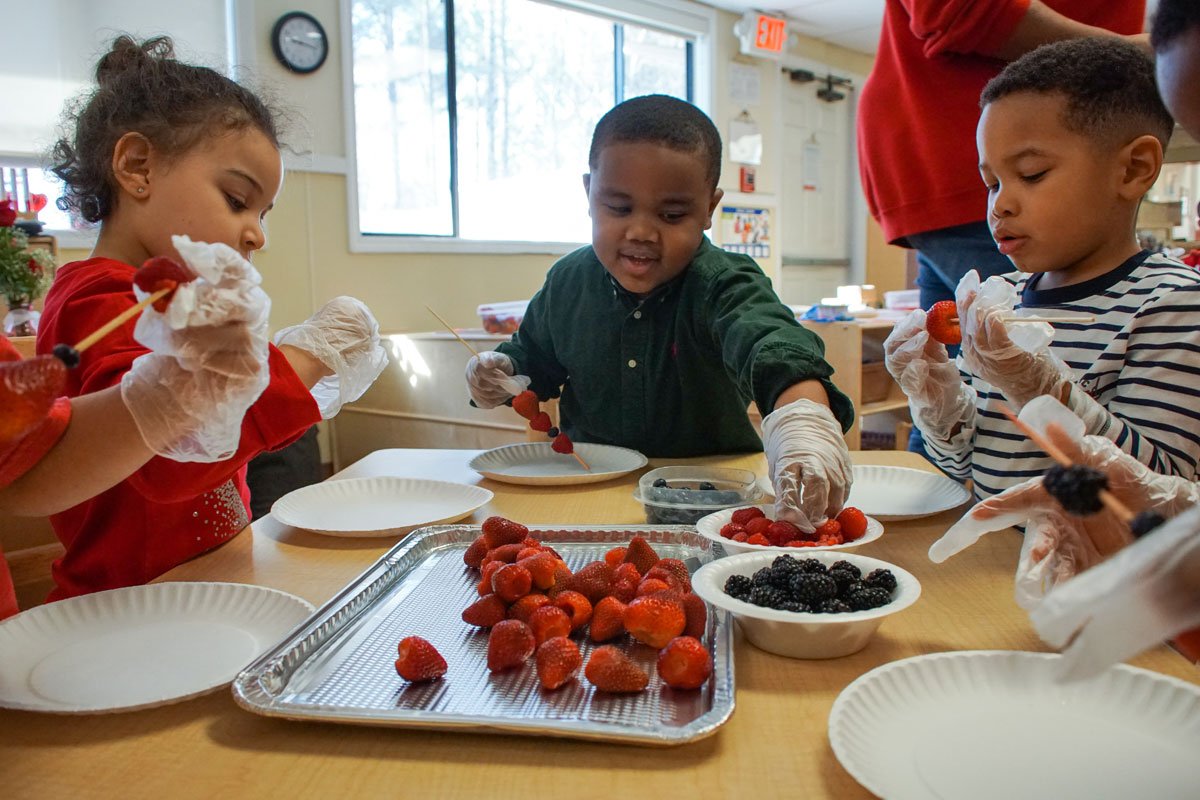A Q&A with local foods expert Dara Bloom explores this untapped potential market for farmers—even though the USDA has eliminated funding for such initiatives.

A Q&A with local foods expert Dara Bloom explores this untapped potential market for farmers—even though the USDA has eliminated funding for such initiatives.
July 28, 2025

Children at La Petite Academy of Raleigh–Hedingham in Raleigh, North Carolina, make berry skewers as part of a farm-to-ECE program. (Photo credit: Marcello Cappellazzi)
Ever since the pandemic, the child care sector has grappled with tight budgets, staffing shortages, and low wages. Dara Bloom, an associate professor at North Carolina State University, has watched over the years as many of these centers have struggled to serve fresh fruits and vegetables to kids, especially when inflation and food prices soared.
Expand your understanding of food systems as a Civil Eats member. Enjoy unlimited access to our groundbreaking reporting, engage with experts, and connect with a community of changemakers.
Already a member?
Login
Last year, federal stabilization grants provided to the child care sector during the pandemic ended, leaving many centers in “survival mode,” says Bloom, a local foods extension specialist who is diligently working to build relationships between child care facilities and small farmers. Through her research, Bloom, herself a mom, hopes to improve food access for underserved communities and economic opportunities for small farmers. She says the child care sector can play a key role—if given the chance.
“Those early [childhood] stages are so important, especially in terms of health and nutrition. It’s a chance to set children’s taste preferences early.”
Child care centers were set to receive a helping hand this year, after the U.S. Department of Agriculture (USDA) expanded the Local Food for Schools (LFS) program last October to include child care sites. Under the Biden administration, the program earmarked $188.6 million for fresh, local produce for child care facilities already participating in the Child and Adult Care Food Program, which reimburses the centers for providing healthful meals and snacks.
Participating sites range from home-based ones serving up to 15 kids to large private daycare providers and programs connected to public school systems, such as Head Start and Early Head Start.
The additional LFS funding would have been a game-changer for the child care industry, Bloom says. But five months after the USDA expanded the LFS program to child care, the Trump administration terminated the program. The decision sparked extensive media coverage of the impact on schools and food banks, but child care didn’t receive much attention—because it had yet to receive any funding.
However, child care, an often-overlooked sector, could become a larger part of local food systems, Bloom says. Through a farm to early care and education (ECE) program at the Center for Environmental Farming Systems, where Bloom also serves as assistant director, she tests and evaluates local food supply chains for child care that help create better markets for farmers.
The center then creates resources to help others replicate these systems in their own communities—for example, a step-by-step local food-buying guide for child care that offers guidance on understanding ingredient seasonality, where to find farmers, and how to order and incorporate local farm food on menus.
Civil Eats recently spoke to Bloom about her research, healthy eating habits for children, and how the child care sector can support small and midsize farms.

Dara Bloom visits Locklear Farms in Pembroke, North Carolina, which sells produce to a group of child care facilities as part of a farm-to-ECE program. (Photo credit: Bhavisha Gulabrai)
What are some of the ingredients of a resilient local food system?
In North Carolina, one of the things that has helped our local food system and issues of accessibility is a strong food hub network. If you look at our food system over the years, as things got bigger, we lost some local and regional food system infrastructure.
Food hubs are produce distributors, and a lot of them, especially in North Carolina, are nonprofits, and so they have a social mission. This includes working with small-to-midsize farmers who often need training to produce for a wholesale market, in terms of scale and [compliance with] food safety requirements. Many of our food hubs are selling to schools, and we’ve worked with them to increase purchasing for child care centers. That middle infrastructure along the supply chain really helps.
What role can child care sites play in our food system?
We know from the research how important early childhood is developmentally, in terms of education and emotional, social, behavioral learning. Those early stages are also important in terms of health and nutrition. It’s a chance to set children’s taste preferences early.
Research shows it can take anywhere from eight to 15 exposures to new types of fruits and vegetables for kids to develop those preferences. And if you are a low-income family, it’s hard to put food on the plate that you know your kid isn’t going to eat, eight to 15 times.
You want to give your kid something they’re going to eat, that is going to fill them up, and that they’ll love, especially if you’re on a tight budget and maybe have to say no to a lot of things. So, there is this opportunity in child care to do what maybe some low-income families wouldn’t be able to do, which is to increase that exposure.
What challenges do child care providers face in buying and serving local food?
Over the years, there has been a shift to purchasing more processed foods or relying on canned or frozen foods, especially produce. There can be a lot of work to help those [child care] buyers look at their menus, understand seasonality, and find recipes to try new local products. They also need to figure out how to have the staff time, the skill set, and the equipment that’s needed to process local food, especially fresh fruits and vegetables.
Post-COVID, they’re struggling with staffing. We’ve heard stories about child care programs that will lose their cook and so they’ve got teachers or the director coming in to cook meals. I’ve seen reports that staff wages are so low that they’re often on public assistance themselves.
Finding local farmers and knowing how to approach them or work with them is also a challenge, since that takes extra time, which centers often just don’t have. Space and storage are another piece. I’ve visited some child care centers with kitchens that are smaller than my home kitchen, and they might be preparing a breakfast, snack, lunch, and maybe even an afternoon snack for 150 kids. In that situation, it helps to have pre-chopped fruits and vegetables.
Much of your work is focused on farm-to-ECE programs. What are they and how would the Local Food for Schools funding have impacted farm-to-ECE initiatives?
We see farm-to-ECE programs as having three components. One is local food procurement: sourcing from farmers and getting local food on the plate for meals and snacks. Two is experiential learning in the garden. And three is food-based learning, exposing kids to cooking in the classroom. There’s something about that experiential piece of being in the garden and experiencing the food in the classroom setting and learning about it. Then it’s on the plate, they’ve had those repeated exposures and are more likely to eat it.
When we started doing this work, we heard from a teacher at a child care center who said that parents would ask, “What’s going on? I didn’t think my kid would eat this [vegetable].” They’re so surprised when those behaviors carry over at home. We had a parent who said they went to the supermarket, and their kid was yelling, “I want broccoli!”
Our hope with the funding was to reach new child care programs and expand farm-to-ECE programming to reach more children and families.
Obviously, the funding never began, but farmers could have benefited, too. What can you say about the loss of that money for farmers?
This was an opportunity to introduce farmers to a new market, create interest, and train technical assistance providers at the county level. This assistance could help farmers with barriers to selling to the school system, such as the Good Agricultural Products certification, which can be hard for smaller-scale farmers because of the cost and paperwork.
“The child care market can be a great starting point for farmers who are interested in shifting toward wholesale.”
Also, the school system can be so large that farmers don’t have enough volume for it. Child care is not the largest market, but it can be a great outlet for a smaller scale farm that’s not going to be able to meet the demands of a larger market like the school system.
Child care can also be a great starting point, almost like a steppingstone, for farmers who are interested in shifting toward wholesale. The child care market gives them the chance to work with an institutional buyer while they build their own infrastructure, with the hope that maybe they’ll be able to scale up someday to serve that larger market.
How were you and other food-system players preparing for the funding?
The funding could only be spent on local food, so it had to go directly to farmers—which was a great benefit for farmers, but it didn’t cover any overhead, like administrative fees, for non-farmers. It was hard to find an organization with the capacity to handle that much funding without being able to hire someone or pay for someone’s time to manage the funds, distribution, and record-keeping that would come with it.
We worked with the North Carolina Department of Agriculture to do outreach to partners we thought could distribute the funds. We worked closely with Working Landscapes, which is a food hub that was taking a leadership role in organizing other food hubs around the state. They felt strongly enough that it fit their mission and would be such a benefit to themselves and other food hubs that they were willing to be the fiscal sponsor.
Where will you go from here?
Moving forward, we’ll continue supporting our partners with the resources we have, and then in the future we’re trying to have a plan so that if there is ever funding available, we will know how to best implement it in a way that supports all stakeholders.
We’re trying to continue supporting child care centers, farmers, and food hubs, and we’re hoping to organize regional meetups over the summer. We’re still trying to bring those partners—food hubs and child care centers—to the table. We are creating resource documents from our research, like a local food buying guide for child care centers.
The possibility to work on the program is still there. But sometimes it feels like a lot to ask of child care providers. If they’re struggling to get by, it can be hard to take this extra time and energy and find the funds to do this. But we also know that child care programs are dedicated to the health of the children they serve.
This interview has been edited for length and clarity.

July 30, 2025
From Oklahoma to D.C., a food activist works to ensure that communities can protect their food systems and their future.
January 20, 2025
July 23, 2025

Leave a Comment